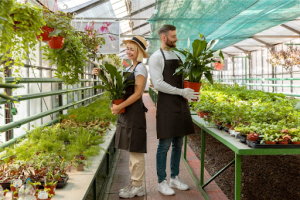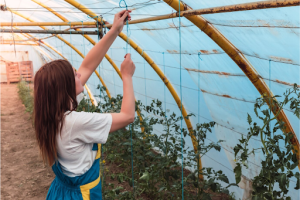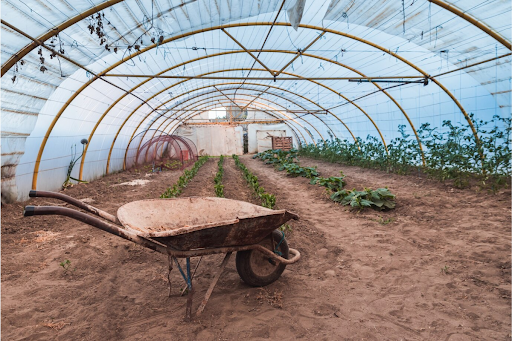Introduction
A high tunnel hoop house is a simple, affordable structure made from metal hoops covered with plastic sheeting. It uses natural sunlight to create a warmer environment, which helps protect plants from frost and extends the growing season. Because it’s easy to set up and doesn’t need much extra equipment, a high tunnel hoop house is a popular choice for beginners or small farms looking for a cost-effective way to grow plants longer into the year.
A greenhouse, on the other hand, is a more solid, enclosed structure typically made of glass or strong plastic. Greenhouses allow gardeners to control the temperature and humidity inside, often using heaters, fans, and other equipment to maintain an ideal growing environment. This makes greenhouses perfect for growing a wide variety of plants, even during the coldest months, allowing for year-round gardening and more plant options.
Hoophouse and High Tunnel Grow Structures
A hoophouse, also known as a high tunnel, is a simple and affordable growing structure used by gardeners and farmers to extend the growing season. Made from curved metal or plastic hoops covered with a sturdy plastic sheet, these structures help trap heat from the sun to create a warmer environment inside. This keeps plants safe from frost in colder months and allows crops like vegetables, flowers, and fruits to grow earlier in spring and later into fall.
Unlike a greenhouse, hoop houses usually don’t have heaters or fans, relying on natural sunlight and ventilation through open sides. This makes them low-cost and easy to maintain. High tunnel hoop houses are popular with beginner gardeners and small-scale farmers who want to protect their crops from weather changes without high expenses. They offer a great way to grow fresh produce for a longer period each year.
We have greenhouses for every grower

Greenhouses are versatile structures that help gardeners grow plants in controlled environments, and there’s a greenhouse option for every type of grower! Whether you’re a backyard gardener, hobby farmer, or large-scale grower, greenhouses let you enjoy year-round gardening by creating a warm, stable climate. Made from glass or durable plastic, greenhouses capture sunlight to keep plants warm and protect them from harsh weather, like frost, wind, and heavy rain.
For beginners or those with smaller spaces, mini greenhouses offer an easy way to start seeds and protect plants. More experienced growers can choose larger greenhouses with fans, heaters, and humidity controls to grow sensitive plants, even in the winter. Unlike high tunnel hoop houses, greenhouses allow growers full control over temperature and humidity, making them ideal for producing healthy plants in any season. No matter the size of your garden, there’s a greenhouse that’s perfect for your needs.
high tunnels and hoop houses
High tunnels and hoop houses are simple but effective structures that allow gardeners to extend the growing season without needing expensive heating or cooling systems. Built from metal or plastic hoops covered with durable plastic sheeting, they create a warm environment by trapping sunlight, which helps protect plants from light frost, wind, and rain. This setup lets gardeners grow crops earlier in spring and later into fall, giving them more time with fresh produce.
Unlike greenhouses, high tunnels and hoop houses don’t typically have added climate controls like fans or heaters. Instead, they use natural ventilation, often by rolling up the sides on warmer days to keep plants comfortable. These structures are especially popular with beginner gardeners and small-scale farmers looking to grow vegetables, flowers, or fruits affordably. High tunnels and hoop houses offer an easy, low-cost way to make the most of each growing season.
The benefits of a cold frame or high tunnel
Cold frames and high tunnels are affordable structures that help gardeners grow plants for longer periods. Both use sunlight to keep plants warm, making them great options for extending the growing season. A cold frame is a small, box-like structure with a clear top that traps heat and protects plants from frost, which is perfect for starting seedlings early or keeping herbs and leafy greens fresh in cooler weather. High tunnels, which are larger, create a sheltered environment with metal hoops and plastic sheeting, allowing for more space to grow a variety of crops like vegetables, fruits, and flowers. Unlike a full greenhouse, neither a cold frame nor a high tunnel needs extra heating or ventilation equipment, making them easy to set up and maintain. These structures are ideal for gardeners who want fresh produce in early spring or late fall without a lot of extra costs.
Attaching Polyethylene Plastic Covering to End Walls

Attaching polyethylene plastic covering to the end walls of a high tunnel or hoop house is an important step to keep plants warm and protected. Polyethylene, a strong plastic, is commonly used to cover these structures because it traps heat, helping plants grow in colder weather. To attach it to the end walls, start by carefully stretching the plastic to fit tightly over the frame, ensuring there are no loose areas where wind could catch and lift it.
Secure the plastic to the frame using staples or special clips, and then reinforce the edges with wooden battens or a wiggle wire track. This method holds the plastic firmly in place, even in windy conditions. A well-attached cover helps keep the high tunnel warm and protects crops from rain, frost, and pests. By properly installing the polyethylene covering, gardeners can create a strong, reliable barrier that keeps their plants safe and growing well.
Conclusion
Choosing between a high tunnel hoop house and a greenhouse depends on your gardening needs, budget, and growing goals. A high tunnel hoop house is affordable and easy to set up, making it a great choice for beginners or small farmers who want to extend their growing season without high costs. By using natural sunlight, it keeps plants warm and protected, allowing for a longer harvest period in the spring and fall.
On the other hand, a greenhouse provides full climate control, making it ideal for those who want to grow a wider variety of plants year-round, even in winter. Although greenhouses require a higher investment, they offer a stable environment with heaters, fans, or vents to keep temperatures just right. Understanding the differences between these structures helps gardeners choose the best option to enjoy fresh produce or flowers, no matter the season.
Read More : Factors Affecting Clover Recovery After Dry Spells

